The pairing is not as unusual as it might seem.

A new dual exhibition featuring Sol LeWitt and Zhang Xiaogang at Pace Gallery Beijing showcases Zhang’s latest works on paper and the geometric-structured sculptures of LeWitt.
The juxtaposition of two artists’ works has brought an intense visual contrast, which has become the focus of this exhibition. LeWitt soberly analyzed in a rational, black and white fashion, while Zhang’s works, painted in delicate colors, are imbued with the warmth of human experience, projecting a sense of time and memories based personal past experience.
“This time, we have two major artists in one exhibition, and what’s important is that these two artists are completely opposite in terms of their concepts,” Leng Lin, curator of the show told artnet News. “Their art practices have shown entirely contrasting concepts, which can be understood by us from today’s globalization point of view regardless of which time periods and contexts they are in. I found this really intriguing.”
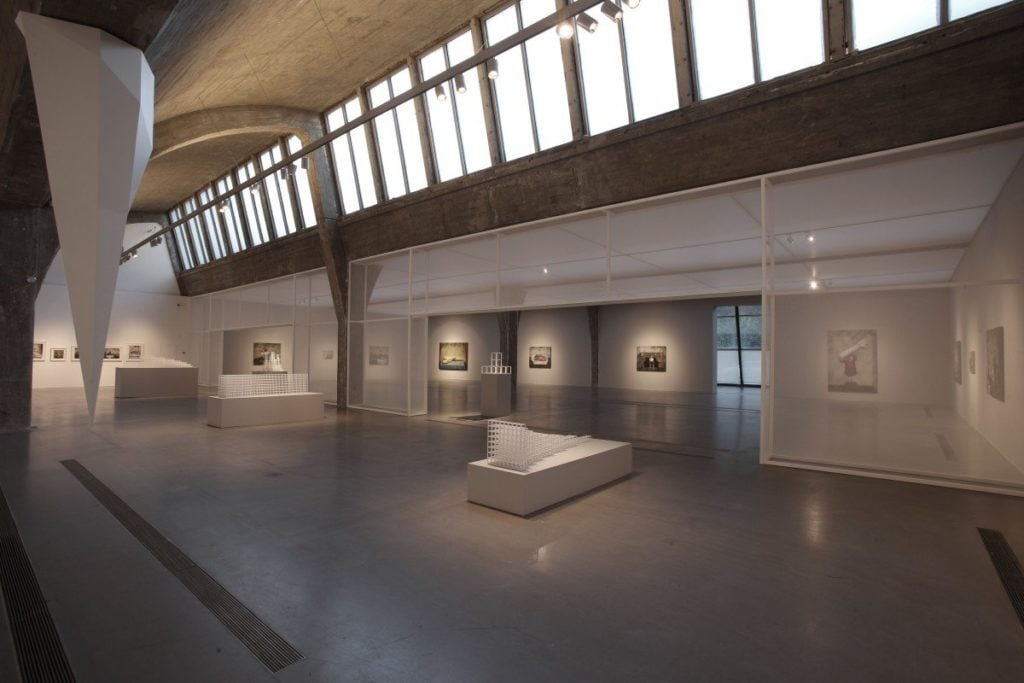
Installation view of “Sol LeWitt and Zhang Xiaogang.” Courtesy of Darbu Photography Studio.
From Leng’s perspective, the basis of this exhibition is not on the logic and development of art language, but instead, the historic tradition of art, the relationship between art and the society, as well as the sensory bond between art and individuals that take over the exhibition stage.
“The exhibition transcends the time and space, which could develop multiple explainable meanings and interpretable space within the opposing and harmonious relation nowadays,” he said. “It involves the questions concerning the East and the West’s relations, so-called advanced and undeveloped values, as well as the standpoints of culture. They are all interlinked and connected, with a new relationship and sensory method of coexisting on the same platform in different times.”
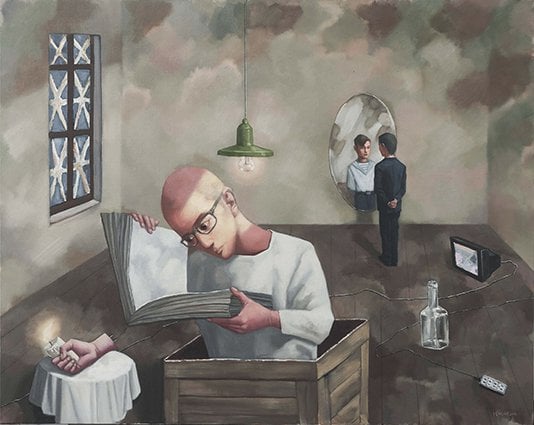
Zhang Xiaogang, The Reader (2016). © 2016 张晓刚.
The exhibition space is divided by a semi-transparent curtain screen from the middle. When those abstract sculptures by LeWitt meet with those faces in zhang’s paintings, we realize that art exists in the experience of intertextuality and the freedom of those two artists’ art.
Leng told us that the arrangement of the works in the space was based on the logics of artworks and the exhibition itself. “The gauze wall has turned conflicts into harmony, rationalizing the exhibiting scene to be accepted. Their works are separated by a gauze screen, through which they look at each other, blending in and being set apart at the same time. Within a half transparent situation created by the gauze wall, their works finally become inseparable.”
artnet News spoke with Zhang about the exhibition and his personal response to Le Witt’s work.
(Translation by Elaine Tan.)
(Translation by Elaine Tan.)
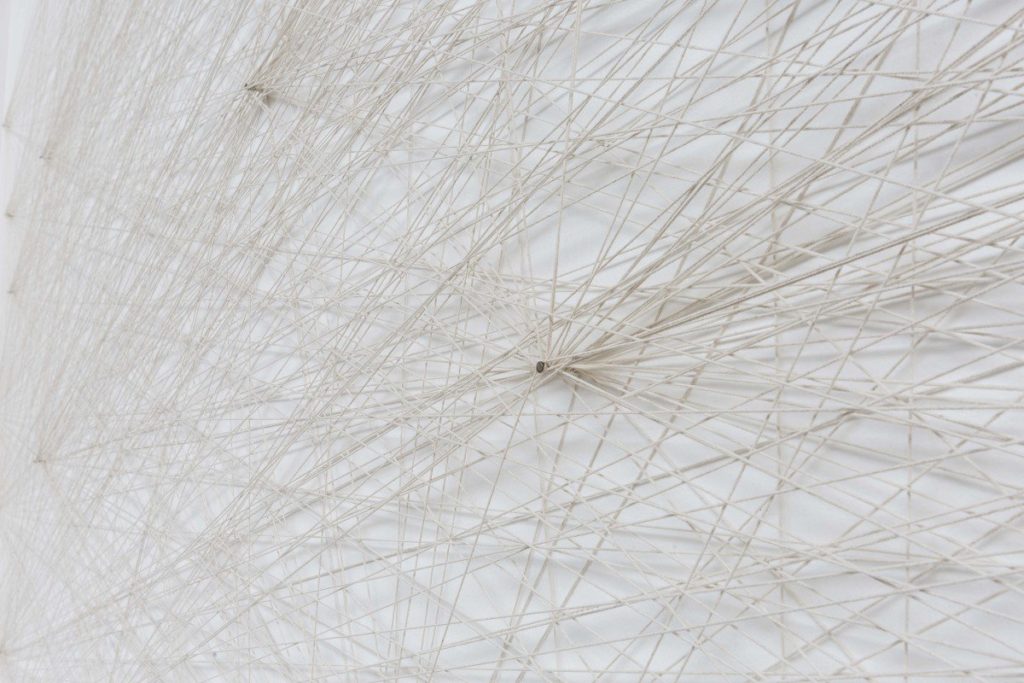
Sol LeWitt, Wall 1097 (detail), 2003. © 2016 the LeWitt Estate/Artists Rights Society (ARS), New York.
What kind of dialogue is uncovered between you and Sol LeWitt’s works?
It’s for the first time that I am in an exhibition with an artist from another space and time whose concept is the opposite of mine. The exhibition displays the essence of Sol LeWitt, who has left his significant impact on the history of art, lifetime achievement.
It’s for the first time that I am in an exhibition with an artist from another space and time whose concept is the opposite of mine. The exhibition displays the essence of Sol LeWitt, who has left his significant impact on the history of art, lifetime achievement.
As a living and aspiring artist, I faced the challenges and pressures one can easily imagine. It turns out not that bad. Two of us turned left and right respectively, with one facing the future in the past times while the other chose to trace back to the past from the present. Since our encounter in Beijing, I feel like I’m clearer about my distinction and direction.
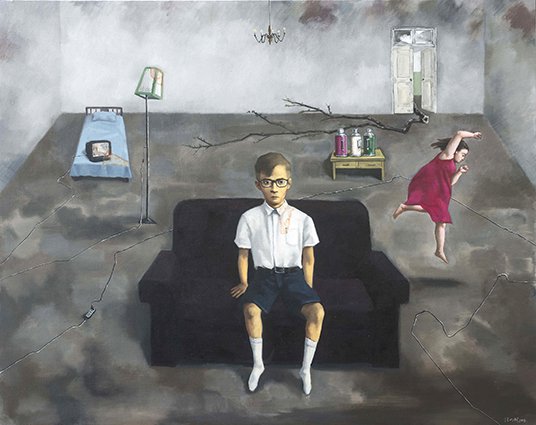
Zhang Xiaogang, Black Sofa (2016). © 2016 张晓刚.
Could you share some thoughts about your new work The Order of the World, which depicts meat and books lying in a bathtub with a fire extinguisher?
These objects come up to my mind at different times. I first wanted to paint steaks, after which was done I thought about what the opposite of meat is. It’s book! The image then turned to be very weird after I added the book to it, and I decided to put them in a bathtub.
These objects come up to my mind at different times. I first wanted to paint steaks, after which was done I thought about what the opposite of meat is. It’s book! The image then turned to be very weird after I added the book to it, and I decided to put them in a bathtub.
If you follow this logic, it isn’t too strange to find out the fire extinguisher in the corner, representing a devastating meaning and the insecurity.

Zhang Xiaogang, Salute Rite (2016). © 2016 张晓刚.
As the title of the work The Order of the World implies, there are various possible interpretations of the work. So how do you understand the relationship between the work and the reality?
In terms of making artworks, I usually don’t sketch, but will take a picture instead. The objects in my paintings seem to only appear with their images in memories.
In terms of making artworks, I usually don’t sketch, but will take a picture instead. The objects in my paintings seem to only appear with their images in memories.
Objects are instantly captured by our eyes. I want to keep a certain distance from the reality, to maintain the beauty of distance. If you get too close to the reality, all you can see is the ugliness of it. I really enjoy the feeling of being in yesterday forever.
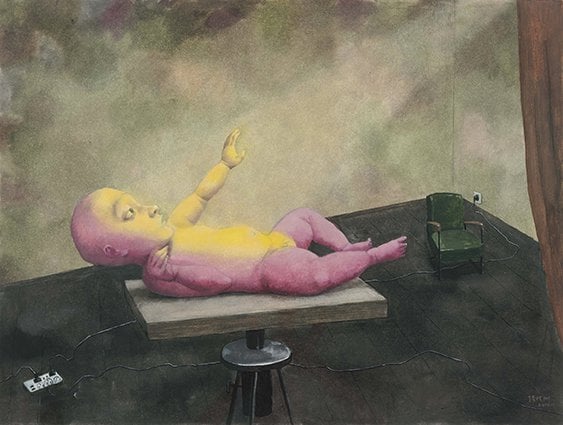
Zhang Xiaogang, Light No. 2 (2016). © 2016 张晓刚.
But the reality is still probably an inevitable subject you have to face as it does exist.
There are always two subjects that artists cannot escape from. One is the reality that includes the milieu you live in, which has really deep influence on Chinese artists. We are always in an extremely passive position when facing our rapidly changing reality.
There are always two subjects that artists cannot escape from. One is the reality that includes the milieu you live in, which has really deep influence on Chinese artists. We are always in an extremely passive position when facing our rapidly changing reality.
The other subject emerges from art itself, and I can’t accurately grasp either. When you just start knowing something, you will be surprised to see changes brought by the time speedily passing by, and then you’ll wonder if the art has developed in response to this situation. The artists of our generation are basically a step behind the times, and I can’t predict tomorrow.
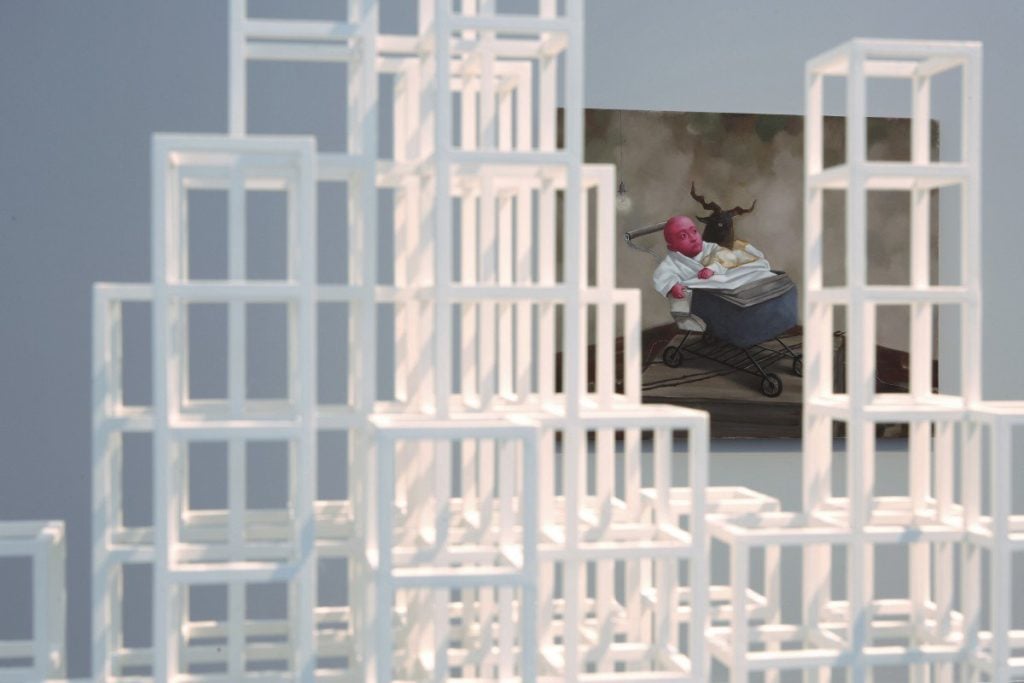
Installation view of “Sol LeWitt and Zhang Xiaogang.” Courtesy of Darbu Photography Studio.
Could you talk about the literary influence in your works?
I think it is related to my early fondness of philosophy and modern literature. I’m always looking for a way to combine philosophy, poetry and art, and this is why a narrative language could be found in my paintings. I won’t be satisfied by only chasing the art itself, sensing that part of expression remains incompletely released inside my body.
I think it is related to my early fondness of philosophy and modern literature. I’m always looking for a way to combine philosophy, poetry and art, and this is why a narrative language could be found in my paintings. I won’t be satisfied by only chasing the art itself, sensing that part of expression remains incompletely released inside my body.
You have spent quite a long time working from histories and memories, Has there ever been a moment that you no longer believed in yourself?
There was a time when I lacked confidence, but it did not matter at all. What really matters is whether you want to express something or not. Life goes on with the core issues and the nature of human being unsolved. At the same, life always stimulates you, enrich you with vivid and fresh experience and sufficiently allows you to constantly prove the core you believe in from multi-angles and multi-layers.
There was a time when I lacked confidence, but it did not matter at all. What really matters is whether you want to express something or not. Life goes on with the core issues and the nature of human being unsolved. At the same, life always stimulates you, enrich you with vivid and fresh experience and sufficiently allows you to constantly prove the core you believe in from multi-angles and multi-layers.
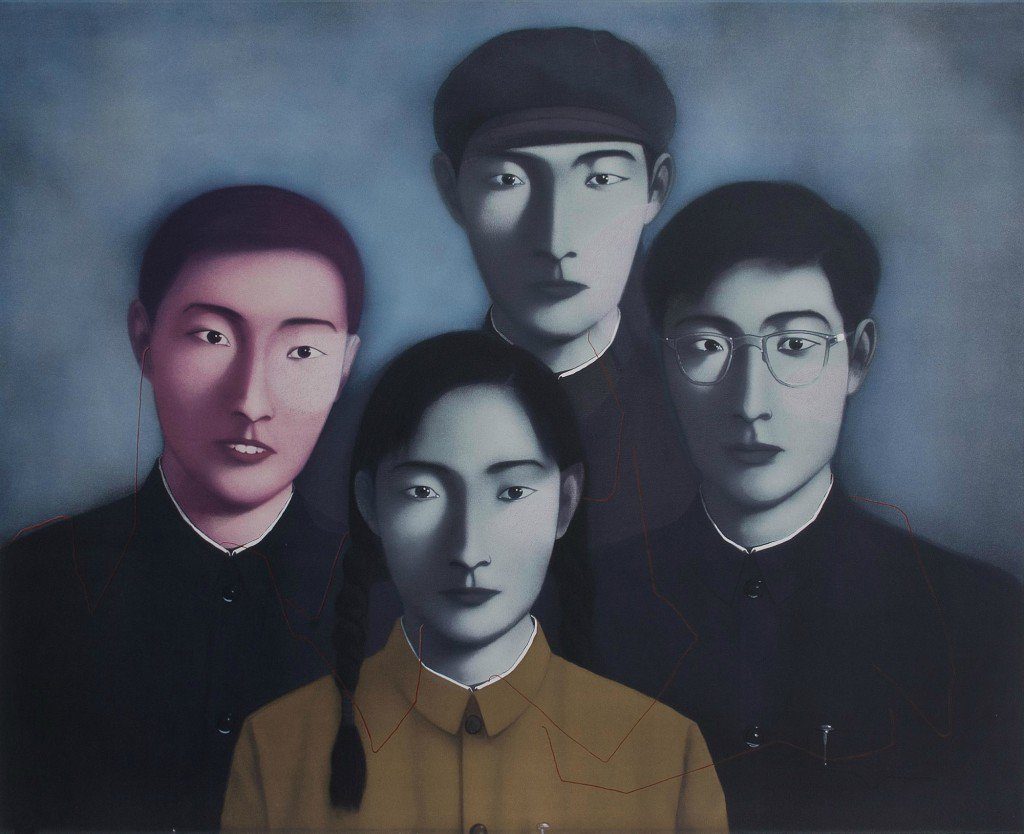
Zhang Xiaogang, Big Family (1996). Courtesy of the artist.
When people look at your works, they are always curious about your family background and the context where you grew up. Does it make you uncomfortable?
No. This is also part of my works. People always like to make conclusions sociologically, but there are still a lot aspects being neglected. In China, it seems that no one like to discuss art on its own.
No. This is also part of my works. People always like to make conclusions sociologically, but there are still a lot aspects being neglected. In China, it seems that no one like to discuss art on its own.
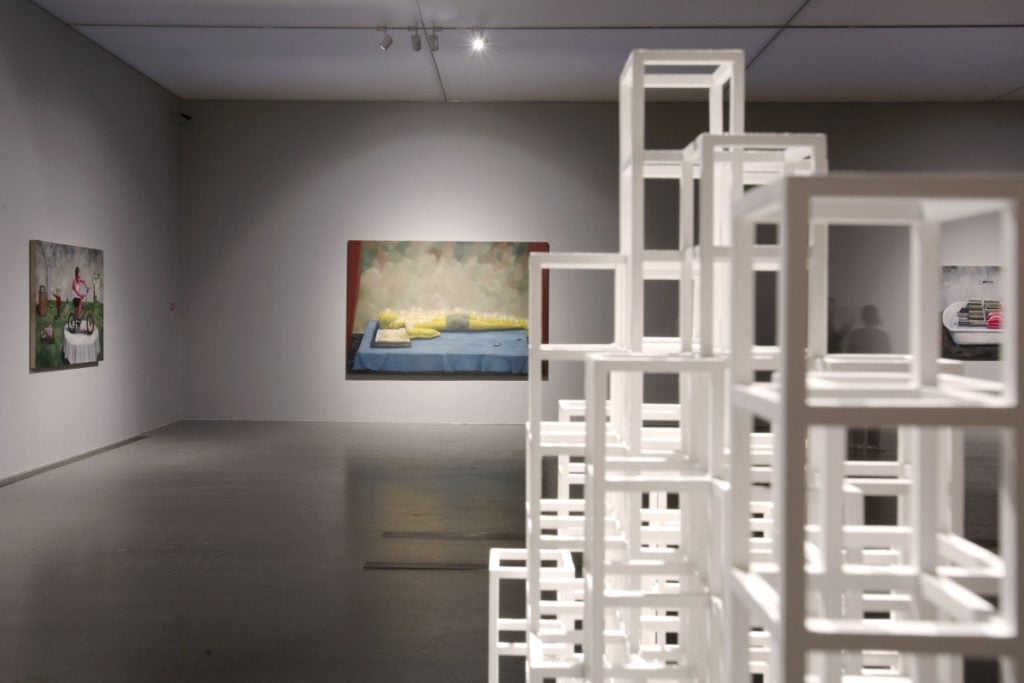
Installation view of “Sol LeWitt and Zhang Xiaogang.” Courtesy of Darbu Photography Studio.
Can you share anything about your future plans?
I have some new ideas, but they won’t be certain until I start to paint. In any case, the most essential thing to me is to live in my own way.
I have some new ideas, but they won’t be certain until I start to paint. In any case, the most essential thing to me is to live in my own way.
This interview was originally published in artnet News China. It has been edited and condensed.
“Sol LeWitt and Zhang Xiaogang” is on view at Pace Beijing, 798 Art District, No. 2 Jiuxianqiao Road, Chaoyang District, Beijing, September 28–November 19, 2016.

No hay comentarios:
Publicar un comentario